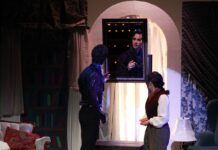Crystal Fairy
Directed by Sebastián Silva
Distributed by IFC Films
When you hear the title Crystal Fairy, an image is instantly evoked of something both delicately tangible and mystically intangible, with bearing in both the physical and the spiritual world.
Both of these descriptions can be loosely applied to one of the main characters of the film, the eponymous Crystal Fairy (Gaby Hoffmann), an American hippie with an unabashed love for dancing, friends, and life.
While the film is essentially an amusing succession of micro-incidents, it is Crystal Fairy’s characterization—along with Michael Cera’s portrayal of the uptight and anxious Jamie, her emotional foil—that gives the story heft and depth.
The film opens with Jamie at a party in Chile, a pit stop on his quest to obtain a San Pedro cactus, a fabled plant that is purported to have potent hallucinogenic properties. He wants to drink the cooked version of the cactus by the sea with his three Chilean friends, played by director Sebastián Silva’s three brothers: Juan Andrés, José Miguel, and Agustín.
Compared to the stronger characters of Jamie and Crystal Fairy, the brothers are almost interchangeable in their service to the story, often serving as mellowing influences on brewing conflicts, usually initiated by Jamie’s irritable mood patterns.
It’s at the aforementioned party that Jamie is drawn to Crystal Fairy, initially by a sense of embarrassment—unreciprocated by her—at her strange dancing style. After an invitation to join them, brought on by a state of drunken enthusiasm on Jamie’s part, Crystal Fairy accepts and shares in an adventure full of mostly random events.
It’s when the film breaks that pattern and begins to simply allow the characters to talk and exist that a fascinating layer of emotional realism is present over the proceedings, particularly with regards to Crystal Fairy herself.
Crystal Fairy isn’t for everyone—it’s a strange, quirky road trip that occasionally meanders and becomes repetitive.
Despite this, there’s a lot to appreciate here, not only with regards to the acting talent, but the cinematography as well.
Throughout the film, especially during the party scenes, the point-of-view is almost like that of a wallflower, or a shy companion along for the ride. That kind of subtle approach to immersing the audience into whatever hijinks the group is up to at any given time is almost undetectable and very effective.
By the end, the audience has been invited to join in on the charming ride with a group of friends who just wanted to get high off cactus juice by the sea, but ended up learning things about themselves and each other along the way.





